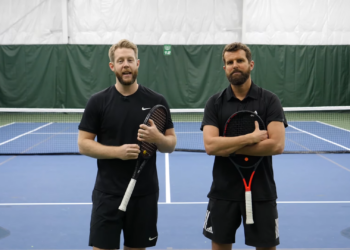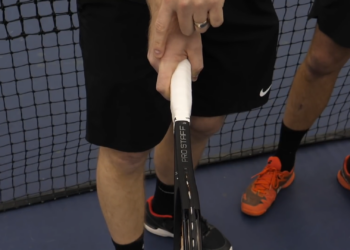Let’s face it, volleying is a statement.
When you step inside the baseline and own the net, you’re telling your opponent, “I’m in charge now.”
But if you’re like most recreational players I’ve coached over the years, the volley feels more like an awkward handshake than a confident strike. Maybe you’re not sure if your grip is right, your racquet keeps twisting, or you feel like you’re swatting flies instead of finishing points.
Been there. Taught that. Fixed it.
Are you ready to learn the real mechanics pros use (and how you can replicate them), how to fix the most common mistakes, and why most players are literally stepping in the wrong direction.
Whether you’re brand new to net play or just want to stop popping your volleys up like beach balls, this guide will walk you through everything you need to level up.
So let’s dive in and turn your volley from a liability into your biggest weapon.
Why the Volley Matters
Most players obsess over their baseline game, grinding out long rallies, tuning their topspin, chasing that elusive “perfect” groundstroke. And sure, consistency from the back is important.
But if you’re not confident at the net, you’re leaving a massive hole in your game. Here’s the truth: the volley is how you finish points.
You don’t volley to rally. You volley to take control.
Why Net Play > Baseline Brilliance (Sometimes)
Groundstrokes give you time. Volleys give you opportunity. But they demand precision.
You’re often dealing with balls hit at you fast, low, and without warning. You don’t have the luxury of a big backswing. Instead, you need compact technique, good joint position, and split-second timing.
That’s why reaction time and racquet preparation matter more at the net than anywhere else on the court.
It’s also why most players struggle.
The Backpedal Mistake That Kills Dreams
One of the biggest worries I hear from players is this:
“Why do I keep missing volleys when I’m moving backward?”
Because you’re not supposed to.
We call this the reverse lunge trap.
You hit a volley, then immediately start backing up to “reset.” The problem? That backward step kills your momentum, throws off your timing, and makes you an easy target for passing shots.
The volley isn’t meant to be played retreating, it’s a shot of intentional forward pressure.
The Foundation – Grip, Stance, and Ready Position
Before we get fancy with volley drills or start talking about slicing angles like Federer, we’ve got to nail the basics. And when it comes to volleys, your grip and your ready position are the bedrock. Miss here, and everything else crumbles.
Get the Grip Right or Nothing Works
If you’re not using a continental grip, you’re sabotaging your volley before the ball even crosses the net.
The continental grip is your “shake hands” grip.
If you were to hold your racquet like you’re greeting someone, with the web of your thumb resting on the top bevel (bevel #2 if we’re getting technical), you’d be in the right spot.
Here’s an even easier visual:
👉 When you hold your racquet correctly, the butt cap should point back toward your wrist. If it’s angled off to the side, you’ve slipped into frying pan territory and we’ve got problems.
A lot of players think they’re using the right grip. But their volleys tell the truth.
The Power of Proper Ready Position
Most players think of ready position like a one-size-fits-all squat. Not true. At the net, your ready position needs to be tuned specifically for volleying.
First, keep your racquet up and in front of your torso, never down by your knees or flailing off to the side. Your elbows should be slightly bent, with the tip of the racquet angled up and forward.
This gives you compact control and allows for rapid reaction time.
Now here’s a unique insight we teach at PlayYourCourt:
Your backhand side covers more of your body than your forehand, about 70% of it.
That means if your racquet is centered or leaning toward your forehand side in your ready position, you’re immediately at a disadvantage.
Players who start in a forehand-dominant stance often react late on backhand volleys and in tennis, late = loss. By shifting your ready position slightly to favor your non-dominant side, you make quicker, cleaner contact on both sides and get more time to react on what’s statistically the more common shot.
This one tweak alone can fix a dozen downstream problems, missed backhands, slow transitions, and yes, those infamous “off-the-frame” mishits.
Bottom line: if your grip and ready position aren’t dialed in, your volleys won’t just be inconsistent, they’ll be doomed. But once you lock in the right hold and stance, you’ll instantly feel more control, more confidence, and more command at the net.
Technique Breakdown – Forehand and Backhand Volleys
You’ve got the right grip. Your ready position is solid. Now comes the fun part, actually hitting the volley.
But before we dive into drills and directionals, let’s clear up one of the misconceptions in all of tennis…
The “No-Swing” Myth, Debunked
You’ve probably heard it before: “Don’t swing at your volleys!” And like most half-true tennis advice, it’s not wrong… but it’s definitely incomplete.
What coaches mean is don’t take a big backswing. But the idea that you shouldn’t swing at all? That’s how you end up with blocky, timid volleys that float instead of pierce.
The truth? A compact, forward swing is absolutely necessary, especially when you want depth, pace, or placement. Think of it less like a swing and more like a push or a punch that starts and finishes out in front of your body.
Players often take the racquet behind their body in an effort to generate power, but all that does is wreck timing and cause mishits. The ball is already coming with pace. Your job is to redirect it efficiently, not recreate a groundstroke from six inches off the net.
Keep your racquet in front. Use your legs and your core. Then push forward through the ball. You’ll be amazed how much control you can generate with just a few inches of racquet travel.
Mastering the Backhand Volley (The Hardest Shot in Tennis)
If you’ve ever watched a player freeze up on a backhand volley, you already know: this shot is tough. Most teaching pros will tell you it’s one of the hardest things to teach and to execute.
Here’s how we simplify it.
First, think of your joint sequence like a chain reaction:
Wrist → elbow → shoulder.
The wrist should be neutral, not bent back or curled in. The elbow leads the movement slightly, and the shoulder provides support, not swing.
Keep the whole unit compact and in sync, like one connected piece.
Next, initiate the shot with a pivot from your outside foot. For righties, that’s your left toe. That pivot creates the angle and body alignment you need to stay stable while attacking the ball.
No pivot = no balance = shank city.
To train this motion, we recommend a simple solo drill:The One-Arm Wall Bounce.
Stand a few feet from a wall with a tennis ball and your racquet. Feed the ball underhand and try to volley it softly back to the wall with just your backhand, one hand only.
You’ll immediately feel if your racquet and arm are working together or not. It’s brutally honest feedback.
Stick with it, and you’ll groove the feel of racquet-arm unity, which is the key to both power and control.
Fixing the High and Low Volley Mistakes
Let’s talk about the two ends of the spectrum, high volleys and low volleys, because players mess these up in completely different ways.
The High Volley: Avoid the Whack-a-Mole Trap
Here’s the scene: you get a high sitter at the net, and you wind up like you’re playing whack-a-mole at a carnival. Big downward chop. Pop the ball straight into the net or straight up for an easy pass.
Sound familiar?
Instead of leading with the top of your racquet like a hammer, lead with the edge, that 3 o’clock or 9 o’clock part of your frame, and angle it slightly forward.
You’ll still drive the ball down, but you’ll keep it skidding low and fast, rather than rebounding high.
The Low Volley: Stop Scooping with Spin
Low volleys are even trickier. Most players instinctively drop their racquet too far and try to “lift” the ball with topspin. That topspin scoop works great on groundstrokes, but at the net, it just opens the strings and sends your volley floating long.
Again, the fix is to lead with the racquet edge. Slightly open the strings, guide forward and up just a touch, and let the racquet’s angle and backspin do the work.
Volleys aren’t about muscle. They’re about mechanics. And once you ditch the myths and feel how little movement it actually takes, you’ll start winning points you used to flub and looking smooth doing it.
Footwork That Transforms Your Net Game
You can have textbook technique and perfect grip, but if your feet betray you, the volley falls apart. Great net play is about where your body is when the ball arrives. And nothing messes that up faster than faulty footwork.
Let’s fix that.
The Reverse Lunge Trap
One of the biggest killers of clean volleys? Stepping backward after contact.
This is what we call the reverse lunge trap and it’s surprisingly common, even among intermediate players.
You hit a volley, then instinctively step back into your ready position. The idea is to reset, stay balanced, maybe avoid the lob.
The reality? You just gave up court position, stalled your momentum, and froze your feet.
And when the next ball comes? You’re flat-footed, leaning back, and late. That second volley becomes almost impossible to execute, especially if it’s wide or dipping.
Use Momentum Like a Pro
Here’s the volley truth no one tells beginners: You should never hit a volley flat-footed.
The energy to strike the ball comes from your legs and core, not your arm, and the only way to harness that is through forward momentum.
Let’s walk through it:
- You approach the net and hit a volley.
- Instead of stepping back or stopping cold, you let your non-dominant foot land forward (left foot for righties).
- You stay low, chop-step forward, and immediately prepare for the next volley.
- Now you’re cutting off the angle for a passing shot, staying aggressive, and setting up an easy put-away.
Why Stopping Cold Costs You the Point
Let’s say you do everything right: you close in, hit a solid first volley… and then freeze. You’re standing tall, heels down, watching your shot like a statue.
The opponent blocks the ball cross-court and now you’ve got to cover 6 feet of space… from a dead stop.
That hesitation is the difference between winning the point and lunging at a ball you can’t reach. Volleys are a continuous motion. When you stop moving, your positioning collapses.
Footwork is the engine behind your volley game. Once you clean up how you move before and after contact, your volleys will become deadly tools to finish the point.
Drills and Practice for Volley Mastery
You don’t need a fancy facility or even a partner to build a world-class net game. Whether you’re training at home or hitting the courts, these drills will sharpen your technique, boost your confidence, and make those match-day volleys second nature.
At-Home Volley Workouts
Volleying is one of the few tennis skills you can refine solo, indoors or out.
The key is building racquet-face awareness, hand-eye coordination, and joint stability, all of which can be trained without a coach feeding you balls.
🔁 Wall Drills: Your Built-In Training Partner
Find a solid wall (garage door, basement wall, brick exterior). Start close—about 6 feet away.
- Forehand volleys: Use a short, controlled punch. Keep the racquet in front and lead with the edge.
- Backhand volleys: Same rules apply. Compact swing, racquet out front, elbow and wrist locked in.
- Catch-and-bounce method: Let the ball bounce off the wall, catch it on your strings, and softly bounce it back. It trains soft hands and racquet control.
Ten reps of each, alternating hands and angles, will dial in your feel fast.
🎯 Self-Fed Volley Series
No wall? No problem. Nate and I teach this in our PlayYourCourt challenges all the time.
- Start in ready position.
- Toss the ball underhand slightly in front of you.
- Volley it back to yourself, focusing on:
- Wrist stability
- Edge-led contact
- Minimal swing
You’ll immediately notice if your joint position is off if the racquet face is open or you’re flicking the wrist, the ball won’t come back clean. This drill builds precision and muscle memory.
On-Court Drills to Improve Timing and Feel
Once you’re on the court, it’s time to recreate game-like situations. Don’t just rally – train deliberately.
🤝 Throw-Catch Volley Drill (Partner Required)
One player stands at the net, the other at the baseline with a bucket of balls. The baseline player underhand tosses balls to random locations at net height. Net player focuses on compact footwork and touch.
🔥 Live Feed + Reaction Volleys
Have a partner rally balls hard and fast at you from mid-court. You’ll train:
- Split step timing
- Reaction speed
- Compact recovery steps
Play 3–5 balls in a row, keeping the ball in play, not trying to end points. This builds control under pressure.
🎮 No Coach? Simulate Match Speed
Set up a ball machine if you’ve got access, or have a hitting partner feed random volleys at various speeds. Mix in:
- High floaters for putaways
- Low skidders for drop volleys
- Body shots to practice defense
Use targets (cones or taped zones) to train directional control.
When and Why to Volley in a Match
If you’ve been grinding out long rallies and wondering when to take control, here’s your sign: the volley is your green light. But knowing how to volley isn’t enough, you’ve got to know when and why.
Transition Zones
There are two main types of volleys:
- Approach volleys: Played while moving in, often off a short ball.
- Finishing volleys: Played close to the net, with the intent to end the point.
Knowing which zone you’re in changes your footwork, preparation, and intent.
Approach volleys need to be controlled and deep to give you time to close.
Finishing volleys can be shorter, angled, or softer to force errors or finish the rally.
Tactical Reasons to Volley
Volleying is a smart strategy. Here’s why:
- Close the net: Cut off angles and take time away from your opponent.
- Draw the lob: Force your opponent to attempt a risky shot over your head.
- Punish weak returns: If they float a short ball, don’t hang back – step in and make them pay.
- Neutralize baseliners: Players who camp out behind the baseline hate being rushed. The volley changes the rhythm.
Volley Mistakes to Avoid at All Cost (And How to Fix Them Fast)
Even seasoned players fall into the same volley traps, and they’re usually fixable with one or two small adjustments. If you’ve ever felt like your volley just doesn’t click, chances are you’re making one of these mistakes.
Stopping After the First Volley
Volleys aren’t one-and-done. If you stop your momentum after the first shot, you’re vulnerable. That’s when you eat a passing shot down the line or get caught flat-footed on a lob.
The Fix: Flow through the volley. Let your momentum carry you forward, follow with chop steps, and reset in an aggressive ready position. Keep the pressure on until the point’s over.
Stepping Across Your Body
Stepping across the body, especially on the backhand, locks your hips and kills your balance.
The Fix: Pivot instead. For backhand volleys, load on the outside foot (left for righties) and turn from the hips. This keeps you open and balanced, ready to explode to the next shot.
Playing with a Forehand Grip at the Net
If you’re using a forehand grip at net, congrats, you’ve made volleying ten times harder than it needs to be.
The Fix: Switch to a continental grip (aka shake-hands grip). It’s the only grip that lets you hit forehand and backhand volleys without switching. More reach, more control, less chaos.
Volley FAQs Answered
“Should I swing or just punch?”
Some swing is okay as long as it’s compact and forward. Think “push” more than “punch.” Big swings kill control. A short swing with forward energy adds depth and placement without risking the shot.
“Why do I miss volleys when off-balance?”
Because balance is everything. If your feet stop moving, your upper body compensates and control disappears. Stay low, stay light, and use split steps or chop steps to keep your weight centered and mobile.
“What does a ‘soft hand’ actually mean?”
A soft hand is all about grip pressure. Instead of squeezing the racquet like a hammer, you hold it with just enough tension to keep control but enough looseness to absorb pace. Great for drop volleys and touch shots.
From Net Beginner to Net Master
If you’ve made it this far, it means one thing: you’re serious about improving your net game.
The fix doesn’t start with more matches, it starts with better habits. And not all at once. One cue at a time. One drill at a time. One rep at a time.
Because momentum, not perfection, wins points.
Volleying isn’t about looking pretty or hitting like Federer. It’s about being aggressive, being in position, and staying connected from your feet to your fingers.
Every smart, repeatable movement builds confidence and confidence turns into wins.
We’re helping you improve faster with everything you need – guided challenges, video coaching, live workshops, and personalized tools to fix the shots that hold you back.
🎾 Ready to master your net game?
Join PlayYourCourt for 7 days free and get custom coaching that’s fun, fast, and actually works. Let’s take your volleys, and your game, to the next level.



